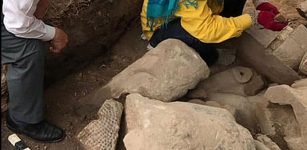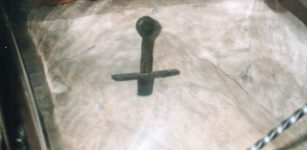Chogha Zanbil: Huge Ancient Still Existing Ziggurat Dedicated To God Inshushinak
Angela Sutherland - AncientPages.com - In the local dialect, the Chogha (also known as Tchogha) means abnormal hills, and “Zanbil” means the basket, and since this site was in the form of a reverse basket before drilling, they called it Chogha Zanbil. It was also referred to as the trash hill
The structure is an ancient still existing ziggurat located in the province of Khuzestan in Iran. This impressive structure, estimated to be about 3,000-years-old belonged to the Elam civilization that ruled 3500 BC.
Chogha Zanbil constitutes the remains of Dur Untash City (or the City of Untash, in Elamite), and it is situated not far from the city of Susa, dated back to 4000 BC. The city was under the reign of the Babylonian, Persian, and Greek Empires.
There was once a large architectural complex that included a huge stepped pyramid-like temple (ziggurat) dedicated to the Sumerian god Inshushinak, one of the major gods of the Elamites and the guardian deity of Susa.
Some scholars speculate, based on a large number of temples and sanctuaries at Chogha Zanbil, that Untash-Napirisha attempted to create a new religious center (possibly intended to replace Susa) that would unite the gods of both highland and lowland Elam at one site.
Kneeling Bull holding spouted vessel, Proto-Elamite; Susa, Iran; Around 3100-2850 BCE. Image credit: iranchamber.com
The entire complex consists of the magnificent Chogha Zanbil ziggurat (the largest structure of its kind in Iran, originally 53 meters high), 13 temple buildings, of which only four are well preserved, and three palaces.
The ziggurat’s irregularly shaped outer wall extends approximately 3,900 by 2,600 feet (1,200 by 800 meters) around the inner sanctum. The square base of the ziggurat, 344 feet (105 meters) on each side, was built mainly of brick and cement. It now stands 80 feet (24 meters) high, less than half its estimated original height. Thousands of bricks that were never used and only left at one side are the reason for believing that the king had construction plans to build 22 temples but unfortunately, he was not able to finish his project.
For a long time, the place was unknown to the outside world, but finally, the ziggurat was accidentally discovered in 1935 by British Petroleum during an oil searching project.
First known archaeological studies of the site were conducted in the late 1930s. Later, between 1946 and 1962 excavations were carried out by the archaeologist Roman Ghirshman.
The monuments were decorated with glazed baked bricks, gypsum, and ornaments of faïence and glass. The ziggurat was once topped with a temple, and some of the bricks had Elamite cuneiform inscriptions on them and inscribed by hand. What distinguishes Ziggurat Dur Untash from other ziggurats in Mesopotamia is that in them, the upper floors were built on the lower floors.
The central ritual section of the ziggurat had 7 portals and there were 7 sacrificial places in front of the southeastern staircase. In one of the palace ruins, archaeologists found five underground tombs with precious items and the remains of four cremated bodies. The Elamites traditionally buried their dead, and the reason for the cremation is unknown. Glazed terracotta statues depicting bulls and winged griffins guarded the entrances to the ziggurat.
The ancient artifacts unearthed at the site include several bull sculptures of Inshushinak and a collection of Middle Elamite cylinder seals.
The ziggurat is considered to be the best-preserved example in the world. In 1979, Chogha Zanbil became the first Iranian site to be inscribed on the UNESCO World Heritage List.
Written by A. Sutherland - AncientPages.com Staff Writer
Copyright © AncientPages.com All rights reserved. This material may not be published, broadcast, rewritten or redistributed in whole or part without the express written permission of AncientPages.com
Expand for referencesMore From Ancient Pages
-
 Islands Of The Tropical Pacific Ocean Were Settled Much Earlier Than Previously Thought – New Theory
Archaeology | Dec 20, 2022
Islands Of The Tropical Pacific Ocean Were Settled Much Earlier Than Previously Thought – New Theory
Archaeology | Dec 20, 2022 -
 Newspaper Rock Art: Ancient Indian Petroglyphs Tell 2,000-Year-Old Story Of Utah
Civilizations | Nov 28, 2018
Newspaper Rock Art: Ancient Indian Petroglyphs Tell 2,000-Year-Old Story Of Utah
Civilizations | Nov 28, 2018 -
 Secret Hidden Freemasonic Messages Concealed In Ancient Egyptian Artifacts And Roman Works – A Misunderstood Object? – Part 1
Ancient Mysteries | Feb 18, 2022
Secret Hidden Freemasonic Messages Concealed In Ancient Egyptian Artifacts And Roman Works – A Misunderstood Object? – Part 1
Ancient Mysteries | Feb 18, 2022 -
 ‘Flower Burial’ And Shanidar Cave With Neanderthal Remains Who Lived 70,000 Years Ago
Archaeology | Feb 19, 2020
‘Flower Burial’ And Shanidar Cave With Neanderthal Remains Who Lived 70,000 Years Ago
Archaeology | Feb 19, 2020 -
 Ancient Mosaic Floor Decorated With Colorful Floral Designs Re-Uncovered After 40 Years
Archaeology | Mar 25, 2023
Ancient Mosaic Floor Decorated With Colorful Floral Designs Re-Uncovered After 40 Years
Archaeology | Mar 25, 2023 -
 Medieval Manor Of Court De Wyck – Re-Discovered
Archaeology | Oct 10, 2023
Medieval Manor Of Court De Wyck – Re-Discovered
Archaeology | Oct 10, 2023 -
 Mysterious Ancient European Civilization – Puzzling Ancient Egyptian Connection – Part 2
Ancient Mysteries | Oct 23, 2019
Mysterious Ancient European Civilization – Puzzling Ancient Egyptian Connection – Part 2
Ancient Mysteries | Oct 23, 2019 -
 23,000-Year-Old Footprints Are Earliest Evidence Of Human Activity Found In The Americas
Archaeology | Sep 23, 2021
23,000-Year-Old Footprints Are Earliest Evidence Of Human Activity Found In The Americas
Archaeology | Sep 23, 2021 -
 Strange Mist, Unexplained Vanishings And Other Bizarre Incidents – What Is The Connection?
Featured Stories | Mar 8, 2019
Strange Mist, Unexplained Vanishings And Other Bizarre Incidents – What Is The Connection?
Featured Stories | Mar 8, 2019 -
 Illuminated Ancient Manuscripts Reflect 1,000 Years Of Human History
Artifacts | Sep 12, 2015
Illuminated Ancient Manuscripts Reflect 1,000 Years Of Human History
Artifacts | Sep 12, 2015 -
 Vikings’ Encounters With Peculiar White-Dressed Humanoids And Cave Dwellers In Unknown Lands Described In Norse Sagas
Featured Stories | Sep 5, 2024
Vikings’ Encounters With Peculiar White-Dressed Humanoids And Cave Dwellers In Unknown Lands Described In Norse Sagas
Featured Stories | Sep 5, 2024 -
 Geirrod: Giant That Tried To Kill God Thor But Was Killed Himself
Featured Stories | Sep 24, 2019
Geirrod: Giant That Tried To Kill God Thor But Was Killed Himself
Featured Stories | Sep 24, 2019 -
 Rare Discovery: Remains Of An Avar Warrior And A Belt Unearthed In Vinkovci, Croatia
Archaeology | May 3, 2020
Rare Discovery: Remains Of An Avar Warrior And A Belt Unearthed In Vinkovci, Croatia
Archaeology | May 3, 2020 -
 A 2,700-Year-Old Urartians’ Ayanis Castle And Haldi Temple – Soon An Open-Air Museum
Archaeology | Aug 10, 2020
A 2,700-Year-Old Urartians’ Ayanis Castle And Haldi Temple – Soon An Open-Air Museum
Archaeology | Aug 10, 2020 -
 Who Were The Goths And Where Did They Come From?
Civilizations | Apr 16, 2019
Who Were The Goths And Where Did They Come From?
Civilizations | Apr 16, 2019 -
 Varangian Guard: Professional Viking Warriors Highly Valued For Courage, Loyalty, Discipline And Fighting Skills
Featured Stories | Jun 4, 2017
Varangian Guard: Professional Viking Warriors Highly Valued For Courage, Loyalty, Discipline And Fighting Skills
Featured Stories | Jun 4, 2017 -
 Sam Bass Became Texas’s Beloved Bandit And Was Admired By The Poor
Featured Stories | Mar 23, 2021
Sam Bass Became Texas’s Beloved Bandit And Was Admired By The Poor
Featured Stories | Mar 23, 2021 -
 Buddha Statues With Broken Arms, Legs And Without Heads Unearthed In Angkor Wat, Cambodia
Archaeology | Apr 22, 2020
Buddha Statues With Broken Arms, Legs And Without Heads Unearthed In Angkor Wat, Cambodia
Archaeology | Apr 22, 2020 -
 European-Made Sealed Bottles Of Cherries Dated To 18th Century Found At Washington’s Mount Vernon
Archaeology | Apr 23, 2024
European-Made Sealed Bottles Of Cherries Dated To 18th Century Found At Washington’s Mount Vernon
Archaeology | Apr 23, 2024 -
 Mystery Of The Real Sword: How Did A Meter Long Sword End Up In Solid Rock?
Artifacts | Apr 15, 2019
Mystery Of The Real Sword: How Did A Meter Long Sword End Up In Solid Rock?
Artifacts | Apr 15, 2019



